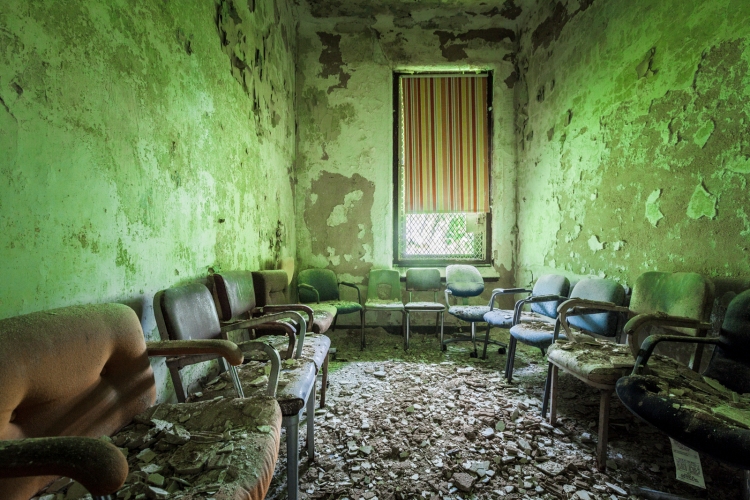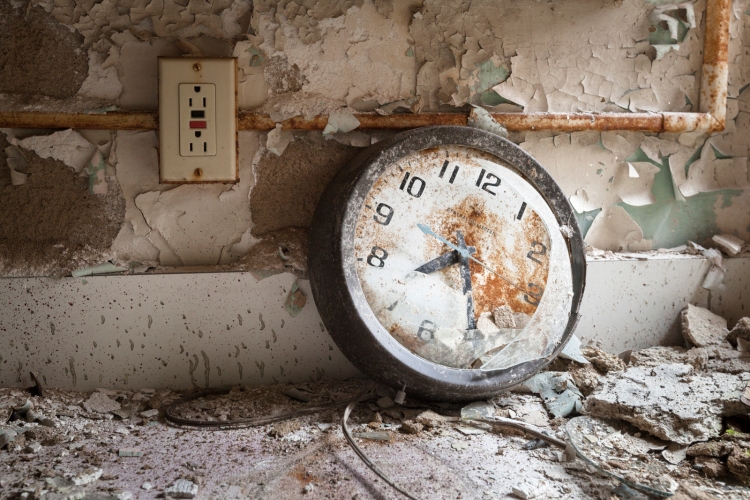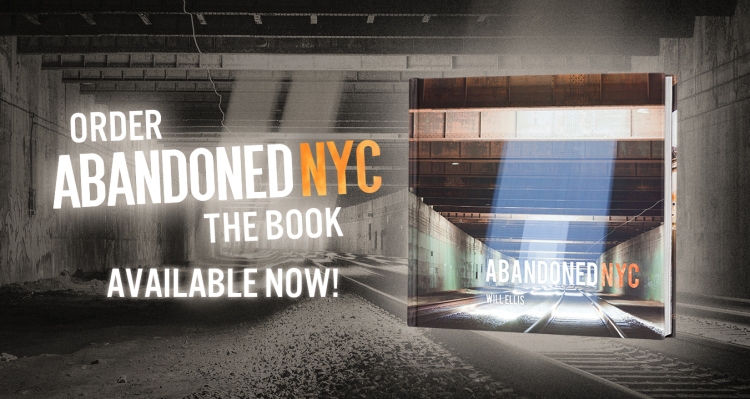
The chairs in this patient room were undoubtedly arranged by a previous visitor to the abandoned hospital.
It seems that everyone in Cedar Grove, New Jersey has a spooky story or two about the Overbrook Asylum. Though it only closed down officially in 2007, the complex has long been home to abandoned buildings, and local lore has been quick to populate them with unexplained voices, vengeful spirits, and mysterious presences. Situated among public parks and residential neighborhoods, the decaying asylum known by many as “the Bin” has become a well-known hangout for teenagers, ghost hunters, scrappers, and other curious parties, much to the consternation of local law enforcement. In 2008, the local sheriff amped up police presence on the property, leading to 34 arrests over the course of 3 days, though it was rented out as a location for the tacky Travel Channel series “Ghost Adventures” the same year. Rumors of 24/7 surveillance still serve to ward off would-be trespassers, but on the gloomy Sunday morning I set out to explore the aging asylum, not a soul, living or dead, patrolled the 100-acre grounds of the old Essex County Hospital.

A clock stopped in an employee kitchen.
I won’t rehash the history here that most every American asylum shares. (For a more detailed account, read up on psychiatric treatments at Kings Park Psychiatric Center and the “farm colony” design of Letchworth Village.) Suffice it to say that the good intentions Overbrook was founded on in 1896 couldn’t hold up to the harsh realities of overcrowding and underfunding that characterized mid-20th century institutions. This dark period of neglect ended, for the most part, with the development of new “wonder drugs” for the treatment of serious mental disorders, which led to the abrupt closure of asylums across the country.
Though there’s little to differentiate the history of Overbrook Asylum from the dozens of similar institutions across the northeast, one particularly notorious episode stands out. On Dec 1st, 1917, the hospital’s heating and lighting plant broke down, sending temperatures plummeting inside the dormitories. As a cold snap hit New Jersey in the following weeks, 24 patients died as a result of or in conjunction with exposure, along with 32 cases of frostbite. In an act of desperation, the medical superintendent sent out letters to patient’s families in the hope that many would come to retrieve their relatives, who he admitted were living in “far from comfortable” conditions.
Even in the best times, “comfortable” isn’t the first word that comes to mind when describing the way of life of the thousands of mentally ill patients who called Overbrook home. An impressive amount of artifacts remain throughout the maze of interconnected dormitories, offering a look into the individual lives that make up its collectively tragic history. At every turn, large-scale photo murals of nature scenes and wildlife adorn the beige and sea foam walls of the wards. Elsewhere, holiday decorations clutter the floor. Stockpiled in cabinets are jolly snowmen, grinning halloween skulls, festive scarecrows, and gleaming easter bunnies, anything to distract from the clinical gloom of the wards. Out of the clustered piles of clothing, medical supplies, and craft projects, the terse, impersonal lines of a handwritten card speak volumes on the isolation of the unfortunate men and women who spent their lives forgotten behind asylum walls: “Dear John, I hope you are well and happy. I’m feeling okay. Miss you. Love, Mom.”

One narrow cell was overtaken by moss and mold.
The decrepit hospital closed down in 2007 when a new state of the art facility opened up nearby, which still operates today. By that time much of the property had already been long abandoned, with a dwindling patient population due in large part to the effective treatments developed in the 60s and 70s, as well as the pressure to discharge anyone who wasn’t a threat to themselves or others, no matter how unprepared they were to get by on their own in the outside world. Contrary to a few adamant commenters in online forums, most of the Overbrook campus is still standing on the east side of Fairview Avenue. A development plan to demolish the complex soon after it closed in 2007 would have brought 78 luxury single family homes to the area, but it never panned out. Today, the property is county-owned. Though plans were put in place to convert the land to a public park in 2008, little progress has been made in that regard.
As Overbrook continues to crumble, the treatment of the mentally ill has been making headlines in recent months, and it’s troubling to see the same familiar patterns play out in an even more brutal setting—the prisons cells and solitary confinement units where many of today’s mentally ill end up. A recent article in the New York Times outlines a harrowing study of an epidemic of violence toward mentally ill inmates at Rikers Island which rivals the worst cases of abuse in the age of institutions. Earlier this week, a positive step was made on the West Coast, where the California Department of Corrections has introduced new standards for the treatment of the mentally ill living in the prison system. Here’s hoping this results in legitimate changes that can be instituted across the country.



















Another super job Will…you never disappoint. I love the new format with the slideshow of large photos…great job!
LikeLike
Posted by Frank | 8-5-14., 6:30 pmThis is the general idea of what I need. A place where I can construct a fully functional “torture chamber/torture school” for my proposed feature. Just someplace in my general area (Brooklyn, Manhattan and/or Staten Island). Thanks and take care, Paul Paul Pastore paulpauliep@aol.com
LikeLike
Posted by Paul Pastore | 8-6-14., 10:26 amOutstanding Will.
LikeLike
Posted by Bob Ellis | 8-6-14., 8:25 pmDo you know if there were private psychiatric hospitals in northern NJ in the 40s – 60s? I am trying to figure out where my father was hospitalized off and on during that time frame and I don’t know if he was in public or private facilities (or which one he died in).
LikeLike
Posted by Julie Covey | 8-14-14., 2:20 pmIt was all connected by underground tunnels. Every building could be accessed via the tunnel system, and all the doors locked immediately when closed. It was a dismal place, and quite scary when, as a student nurse, I got locked in a stairwell on the way back from music therapy, with several patients and other student nurses…and no key. Our pounding of the doors…all the while, not wishing to upset or anger the patients..was ignored for some time. The tunnels were very eerie. My memories were of a place that literally made me physically ill. The over active (as they called the worst) wards with the criminally insane as patients, was the scariest…Why they let student nurses in that ward was beyond me…and the food there…cafeteria..well..if you could get beyond the screaming, cursing patients…Well, it was a very sad place, but kept what became most of our homeless population today, off the streets.
LikeLike
Posted by Sandy | 11-17-14., 8:52 pmI attended Verona High School in my Freshman and Sophmore years which were 1968 and 1969. During this time several other VHS friends and I worked in a cafeteria at Overbrook Mental Hospital. What started out as simply as a way for a teenager to make a few extra bucks turned into a life changing experience, some of which haunts me to this day.
The hospital was split up in distinct areas or zones whose access was determined by the severity of the patient’s illness. The cafeteria was the least restricted area and patients who were somewhat functional were free to enter.
My first observation was the condition of the fingers of the heavily medicated, chain smoking patients. They would sit over a cup of coffee for hours and stare while the non-filtered cigarette, for some reason they all smoked Pall Malls, would literally burn, because there was no filter to self extinguish the cigarette, directly through their fingers. This constant practice left them with deep, black necrotised skin. I was amazed that they could not even feel this.
There was a guy who allowed himself to be called “Dick Tracy” who stood in the hall with a small spiral notepad who wrote down the time and name of every person who walked by his post. He had hundreds of these notepads stuffed in his pants, down his legs, in his shirt and shirtsleeves. He told me he had been doing that for twenty years.
I visited the wards where the most severely ill were warehoused. There were howling adults and children, all housed together, were mostly naked and all were filthy. They were lying on the floor in their own feces and urine while the males constantly masturbated. The stench was overpowering and I could not stay another minute. I was sixteen years old and had never witnessed anything like this in my life.
The most memorable however was a customer named Bob who was obsessed with the certainty that the bomb was going to be dropped on him and it was going to happen today. “Today’s the day for sure! It’s going to happen today” he would say over and over. This was a daily occurrence and we would calm him down then he would be good till the next day.
He was a harmless regular and we always did the best we could to reassure him. Then on my day off, a friend of mine, Jim, thought it would be funny to tell him, “Yup, you’re right Bob, today is the day!” The end of this true story is not good. Bob somehow got ahold of a razor and killed himself.
LikeLike
Posted by Dennis Goddard | 4-23-15., 2:30 amI remember my Grandma having to go here. It was HORRIBLE. She was senile and she lived next door to us. We took care of her but on one occasion she was screaming out of the window “HELP ME” to strangers etc. She was frantic and decided to jump out of the first floor window. She had good days, and bad ones. Well on this “bad” day she was carted away against our wishes because she was a threat to herself. The police sent her to Overbrook. I will never forget one occasion going with my Dad to visit and he was horrified to find her nude sitting in feces rubbing it all over herself. Everyone was screaming and cursing. It broke my father to see her in there. The state would not allow us to take her home. She ended up dying there and we were not told until a few DAYS after her death!!. Things are so different now. A nursing home was not an option then.
LikeLike
Posted by Sue T. | 4-26-15., 10:02 pmI worked at Greenhill in 1962 in the back ward briefly for a year and resided on the grounds. I was a psych.attendant. i am a retired social worker who live in Seattle for past 56 years. What has been described about Overbrook Hospital I remember clearly – something you never will forget. If you don’t think we are animals – you missed working in the back wards of Overbrook. A lot of the patients ended up totally out of it due to syphilis. This was a work experience I will never forget. Peace
LikeLike
Posted by Larry Clark | 3-11-18., 7:27 pmMy grandfather passed away
In Overbrook in the 1957. His name was Gerard Tirico. Is there anyway to obtain any of his records?
LikeLike
Posted by Dorianne Tirico | 6-29-22., 11:14 am